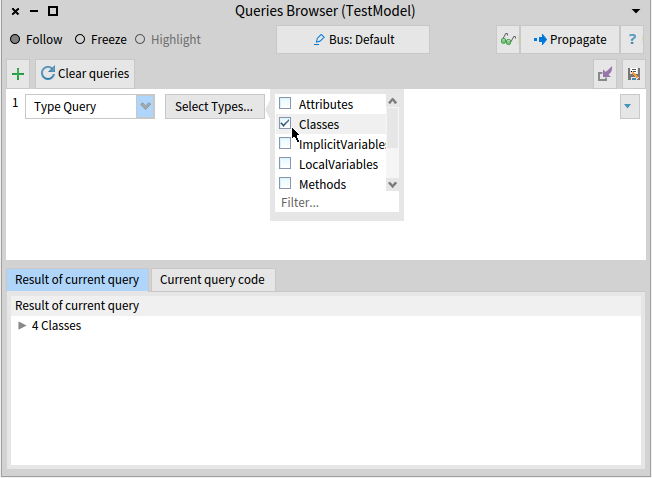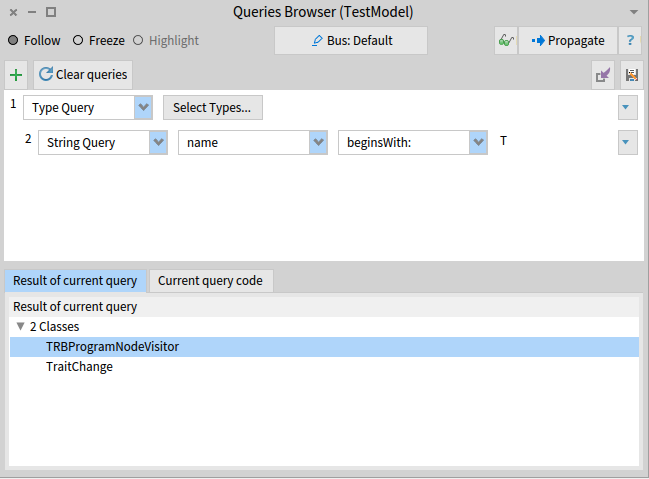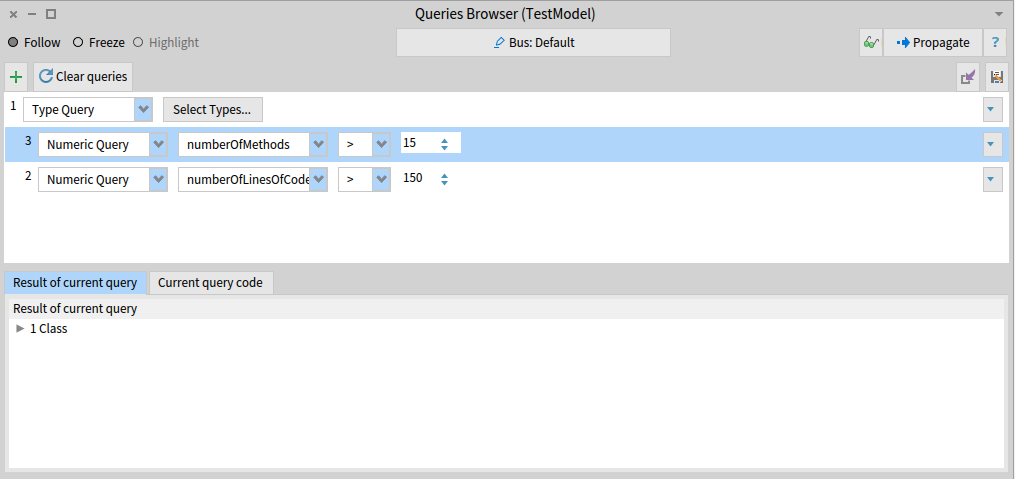This page aims to present different queries one might want to perform when analyzing a model. It can be used as a baseline for further analysis.
We present how to perform the queries in a playground or with the visual tool proposed by Moose.
Queries
Find entity
Class with a specific name
Using the Queries Browser: first, we request all the classes of a model.

Then, we create a subquery that selects the class using their name.

Finally, you can select the entity in the bottom panel.
It is also possible to perform the query in an inspector or playground.
The shortest way to find a class with a name is to use the detect method.
classes := model allWithType: FamixStClass.
withPrefix := classes detect: [ :class | class name = #'MyClassName' ].
Classes with their name beginning with or ending with
When performing queries, it is often useful to start with a substep of classes by looking at their names.
This can be done easily using the beginWith: and the endWith methods.
classes := model allWithType: FamixStClass.
withPrefix := classes select: [ :class | class name beginsWith: #'MyPrefix' ].
withSuffix := classes select: [ :class | class name endsWith: #'MySuffix' ]
God classes
God classes are classes that knows too much or does too much. One way to find god classes is to count the number of lines or the number of methods of a class.
Using the Queries Browser, one can use the Numeric Query on the classes of a model.

Using a playground, one can perform a query on a model to retrieve the god classes by numbers of lines:
model allModelClasses select: [ :each | each numberOfLinesOfCode > 150 ]
Or by numbers of methods:
model allModelClasses select: [ :each | each numberOfMethods > 50 ]
God cyclomatic complexity
The cyclomatic complexity presents the complexity of a program. It basically corresponds to the number of possible branches in a method. The less cyclomatic complexity for a method, the better it is.
The following script sorts the methods extracted in a model by their cyclomatic complexity.
((self model allBehaviourals)
collect: [ :entity | entity -> entity cyclomaticComplexity ]
thenSelect: [ :assoc | assoc value > 3 ]) asOrderedCollection sort: #value descending
Deprecated methods
Deprecated methods are methods existing in the current version of an application, and that will disappear in the next version. Such a method should not be used.
In Java, it is possible to retrieve the deprecated methods by searching the method with the @Deprecated annotation.
model allModelMethods
select: [ :t |
t annotationInstances notEmpty
and: [ t annotationTypes anySatisfy: [ :a | a name = 'Deprecated' ] ] ]
Dead methods
Dead methods are methods that are not invoked by any other methods.
Be careful; some methods might not be directly called but are referenced thanks to abstraction or are dedicated to be extended by another application. It is often the case when dealing with a framework.
model allModelMethods
collect: [ :method | method -> method incomingInvocations ]
thenSelect: [ :assoc | assoc value isEmpty ]) asOrderedCollection
Application tests
^ (model allModelMethods
select: [ :t |
t annotationInstances notEmpty
and: [ t annotationTypes anySatisfy: [ :annotation | annotation name endsWith: 'Test' ] ] ])
asOrderedCollection flattened
Visualizations
Class hierarchy
The class hierarchy presents the classes of a model with their hierarchy links (e.g. superclass, subclasses, …). It also includes the methods and attributes of each class.
The easiest way to visualize a class hierarchy is to use the UML browser.
It is also possible to script one UML visualisation of Roassal.
builder := RSUMLClassBuilder new.
classes := mooseModel allModelClasses.
builder modelDescriptor
instVars: [ :aFamixClass | aFamixClass attributes ];
instVarSelector: [:aFamixAttribute | aFamixAttribute name];
methods: [ :aFamixClass | aFamixClass methods];
methodSelector: [:aFamixMethod | aFamixMethod name].
builder classes: classes.
builder build.
builder canvas @ RSHierarchyPacker.
builder canvas
Packages cycles
tarjan := MalTarjan new.
tarjan nodes: model allModelNamespaces.
tarjan edges: model allModelNamespaces from: #yourself toAll: [ :a | a allProvidersAtScope: FamixTNamespace ].
tarjan run.
tarjan inspect
Developers
Meta-model UML
It is possible to visualize the meta-model with a class hierarchy.
builder := RSUMLClassBuilder new.
classes := FamixJavaModel metamodel classes.
builder modelDescriptor
instVars: [ :metaDescription | metaDescription primitiveProperties ];
instVarSelector: [:metaDescription | metaDescription implementingSelector];
methods: [ :metaDescription | metaDescription complexProperties];
methodSelector: [:metaDescription | metaDescription implementingSelector].
builder classes: classes.
builder build.
builder canvas @ RSHierarchyPacker.
builder canvas
A better solution to explore a meta-model is to use the Meta Browser that provides a detailed view on every important aspects of a meta-model.

